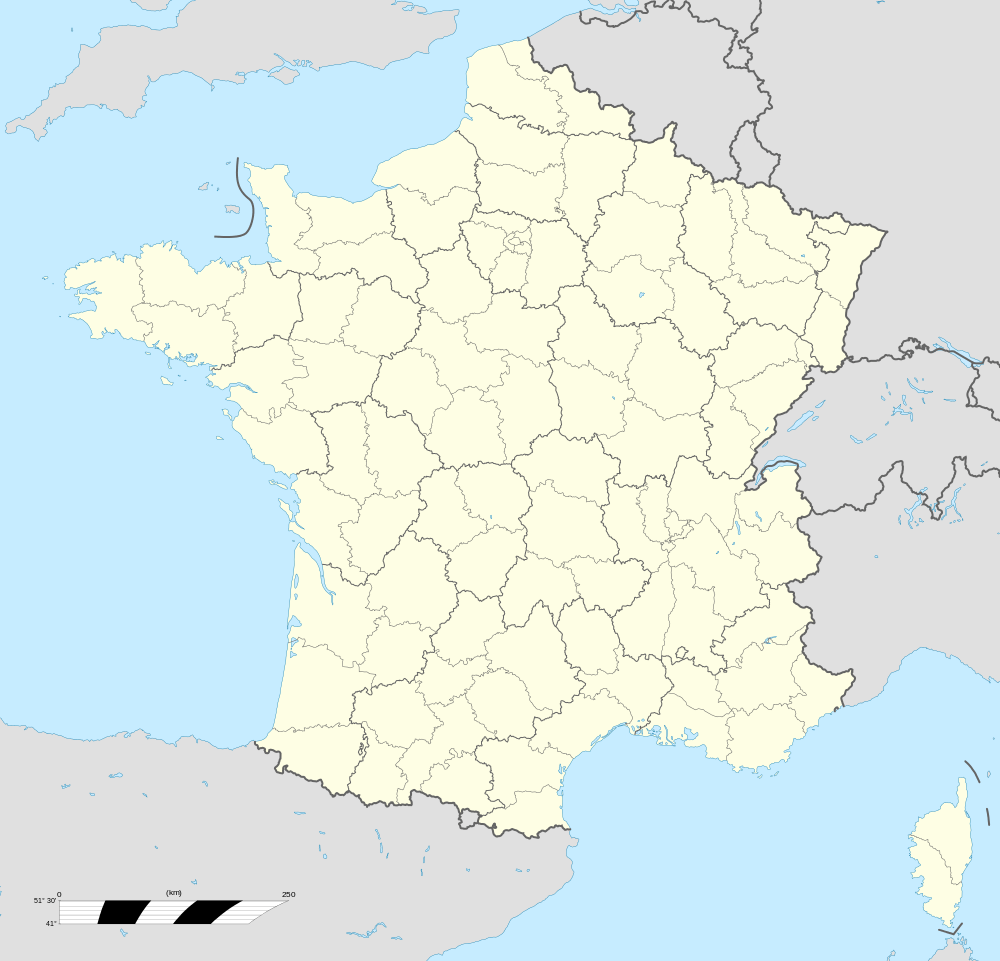Armentières
| Armentières | ||
|---|---|---|
|
The town hall | ||
| ||
 Armentières | ||
|
Location within Nord-Pas-de-Calais region  Armentières | ||
| Coordinates: 50°41′17″N 2°52′52″E / 50.6881°N 2.8811°ECoordinates: 50°41′17″N 2°52′52″E / 50.6881°N 2.8811°E | ||
| Country | France | |
| Region | Nord-Pas-de-Calais | |
| Department | Nord | |
| Arrondissement | Lille | |
| Canton | Armentières | |
| Intercommunality | Lille Métropole | |
| Government | ||
| • Mayor (2008–2014) | Bernard Haesebroeck | |
| Area1 | 6.28 km2 (2.42 sq mi) | |
| Population (2009)2 | 25,089 | |
| • Density | 4,000/km2 (10,000/sq mi) | |
| INSEE/Postal code | 59017 / 59280 | |
|
1 French Land Register data, which excludes lakes, ponds, glaciers > 1 km² (0.386 sq mi or 247 acres) and river estuaries. 2 Population without double counting: residents of multiple communes (e.g., students and military personnel) only counted once. | ||
Armentières (IPA: [aʁmɑ̃tjɛːʁ]; Dutch: Armentiers) is a commune in the Nord department in the Nord-Pas-de-Calais region in northern France. It is part of the Urban Community of Lille Métropole.
The motto of the town is Pauvre mais fière (Poor but proud).
Geography
Armentières lies on the Belgian border, northwest of the city of Lille, on the right bank of the river Lys.
History

In 1668, the town became French like the rest of French Flanders. At the end of the 19th century and the beginning of the 20th, Armentières acquired fame, being the “City of the Fabric”. The industrial weaving, spinning and brewing grew in Armentières, benefitting from the presence of water.
Armentières particularly suffered at the time of the World Wars. However, the town did receive two Military Crosses (one for World War I and the second for the Second World War) and the Legion of Honor. In Armentières and in the neighbourhoods, the military cemeteries are places of remembrance for the casualties of the World Wars. "Mademoiselle from Armentières" was a popular song among Allied soldiers in World War I.
During World War I, in April 1918, German forces shelled Armentières with mustard gas. British troops were forced to evacuate the area but German troops could not enter the commune for two weeks because of the heavy contamination. Witnesses to the bombardment stated that the shelling was so heavy that liquid mustard ran in the streets.[1][2]
Population
| Historical population | ||
|---|---|---|
| Year | Pop. | ±% |
| 1793 | 7,671 | — |
| 1800 | 7,598 | −1.0% |
| 1806 | 7,542 | −0.7% |
| 1821 | 7,681 | +1.8% |
| 1831 | 6,338 | −17.5% |
| 1836 | 6,512 | +2.7% |
| 1841 | 6,817 | +4.7% |
| 1846 | 7,959 | +16.8% |
| 1851 | 8,840 | +11.1% |
| 1856 | 10,104 | +14.3% |
| 1861 | 11,901 | +17.8% |
| 1866 | 15,579 | +30.9% |
| 1872 | 19,035 | +22.2% |
| 1876 | 21,746 | +14.2% |
| 1881 | 25,089 | +15.4% |
| 1886 | 27,985 | +11.5% |
| 1891 | 28,638 | +2.3% |
| 1896 | 29,603 | +3.4% |
| 1901 | 29,401 | −0.7% |
| 1906 | 28,613 | −2.7% |
| 1911 | 28,625 | +0.0% |
| 1921 | 14,758 | −48.4% |
| 1926 | 21,035 | +42.5% |
| 1931 | 22,704 | +7.9% |
| 1936 | 24,049 | +5.9% |
| 1946 | 22,667 | −5.7% |
| 1954 | 24,940 | +10.0% |
| 1962 | 25,248 | +1.2% |
| 1968 | 26,916 | +6.6% |
| 1975 | 26,346 | −2.1% |
| 1982 | 24,834 | −5.7% |
| 1990 | 25,219 | +1.6% |
| 1999 | 25,249 | +0.1% |
| 2006 | 24,836 | −1.6% |
| 2009 | 25,089 | +1.0% |
| 2010 | 25,375 | +1.1% |
| 2011 | 25,704 | +1.3% |
Heraldry
.svg.png) |
The arms of Armentières are blazoned : Argent, a fleur de lys, and on a chief gules a sun and a decrescent Or. |
Railways
| Calais Ville to Gare Lille Flandres | ||||||||||||||||||||||||||||||||||||||||||||||||||||||||||||||||||||||||||||||||||||||||||||||||||||||||||||||||||||||||||||||||||||||||||||||||||||||||||
|---|---|---|---|---|---|---|---|---|---|---|---|---|---|---|---|---|---|---|---|---|---|---|---|---|---|---|---|---|---|---|---|---|---|---|---|---|---|---|---|---|---|---|---|---|---|---|---|---|---|---|---|---|---|---|---|---|---|---|---|---|---|---|---|---|---|---|---|---|---|---|---|---|---|---|---|---|---|---|---|---|---|---|---|---|---|---|---|---|---|---|---|---|---|---|---|---|---|---|---|---|---|---|---|---|---|---|---|---|---|---|---|---|---|---|---|---|---|---|---|---|---|---|---|---|---|---|---|---|---|---|---|---|---|---|---|---|---|---|---|---|---|---|---|---|---|---|---|---|---|---|---|---|---|---|
Legend
| ||||||||||||||||||||||||||||||||||||||||||||||||||||||||||||||||||||||||||||||||||||||||||||||||||||||||||||||||||||||||||||||||||||||||||||||||||||||||||
International relations
Twin towns — Sister cities
Armentières is twinned with:
Famous people from Armentières
- Dany Boon, French actor and stand-up comedian
- Jean Maurice Fiey, Church historian and Syriacist
- Amédée Fournier, French road bicycle racer and Olympic medallist
In fiction
Milady de Winter in The Three Musketeers hides in Armentières and is caught and executed there.
See also
References
- ↑ Heller, Charles E. (September 1984). "Chemical Warfare in World War I: The American Experience, 1917-1918". U.S. Army Command and General Staff College. Fort Leavenworth, Kansas. Retrieved January 15, 2009.
- ↑ http://query.nytimes.com/mem/archive-free/pdf?res=F70C15F93D5A11738DDDAE0894DE405B888DF1D3
External links
| Wikimedia Commons has media related to Armentières. |
- Armentières official website (in French)
- The reconstruction of the town hall of Armentières after WW1 on the website "Remembrance Trails of the Great War in Northern France"